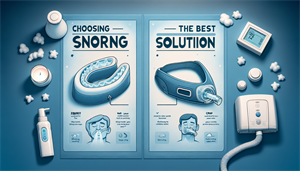
Why Do I Snore When I Sleep on My Back?
Ever rolled over in bed, nudged by your partner’s elbow, or even the harsh sound of your own snoring? If you’ve ever wondered “why do I snore when I sleep on my back?”, you’re not alone. Unraveling the mystery behind snoring is not only intriguing but also crucial to your sleep health and overall well-being.
Key Takeaways
Sleeping on your back can lead to snoring due to gravity causing the tongue and soft palate to collapse into the throat and obstruct the airway, which is worsened by factors like nasal congestion. Lifestyle factors such as excess weight and the consumption of alcohol or sedatives contribute to snoring by relaxing muscles in the throat, leading to increased airway obstruction during back-sleeping. Combating snoring may involve changing sleep positions, utilizing anti-snore pillows or medical devices, and in some cases, surgical intervention, as well as addressing sleep apnea symptoms if present.
The Science Behind Supine Snores
Snoring, especially loud snoring, is often attributed to a narrowed or partially blocked airway during sleep. This inability to move air freely through the nose and throat primarily results from sleeping on your back, a position that invites the effects of gravity on your upper airway. This supine position can lead to the retraction of the tongue and soft palate into the throat, causing airway blockage and the familiar snoring sound we all know too well.
The role of gravity in snoring is often overlooked. Its downward force on our throats while we sleep on our backs, results in: the collapse of the tongue and soft palate into the throat leading to airway obstruction creating an environment conducive to snoring which may hinder a peaceful night’s sleep.
Gravitational Pull and Airway Obstruction
Understanding the impact of gravity on snoring can be a game-changer in our quest for a snore-free, good night’s sleep. When we sleep on our backs, gravity constricts the airway, leading to heightened snoring and potential respiratory challenges. This effect can be exacerbated by a stuffy nose or any other form of nasal congestion. Sleeping on one’s back allows the tongue and soft palate to collapse into the throat, obstructing the airway. This is mainly due to gravity causing the throat to relax and block the airway. The problem can be aggravated by a congested nose, highlighting the importance of managing any nasal issues to curb snoring.
Role of the Soft Palate and Tongue
The soft palate and tongue are not just crucial for tasting and swallowing our favorite foods; they also play a significant role in snoring. Composed of muscle and connective tissue, the soft palate forms the roof of the posterior part of the oral cavity, while the highly flexible and mobile tongue is situated on the floor of the mouth. During sleep, the soft palate may elongate and rest on the base of the tongue, leading to airway obstruction. The muscles supporting the soft tissues in the throat, including the tongue and soft palate, may relax and lose tone, exacerbating airway blockage. A longer or softer roof of the mouth can narrow the opening from the nose to the throat, partially blocking the airway and leading to a hoarse or harsh sound, such as snoring.
Unpacking Sleep Position Dynamics
Your sleep position can significantly impact the severity of your snoring. Sleeping on your back increases the likelihood of airway collapse, leading to more severe snoring. But what if you could adjust your sleep position to decrease snoring? Side sleeping is frequently advised as the optimal position to prevent snoring. It aids in keeping the airway open and prevents the throat muscles from obstructing the airway. However, transitioning from a back sleeper to a side sleeper may not be a walk in the park for everyone. This is where positional therapy comes in.
Sleep Positions and Snoring
Positional therapy involves using various methods to encourage side sleeping, such as specialized pillows, wearable devices, or even tennis balls sewn into the back of pajamas to prevent back sleeping. These methods aim to train the body to remain in a side-sleeping position, reducing the likelihood of snoring. While positional therapy may not be a one-size-fits-all solution, it can be a valuable tool in managing snoring, especially for individuals who struggle to maintain a side-sleeping position naturally.


